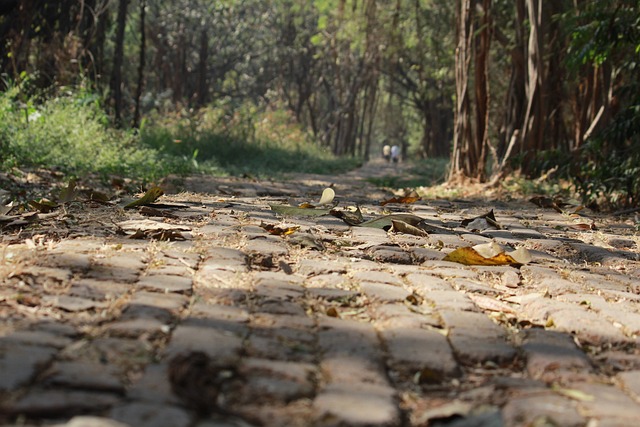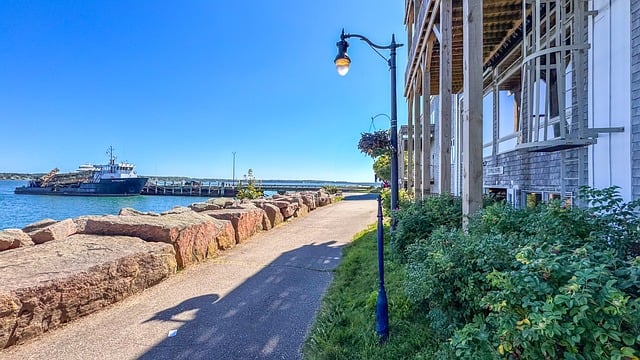The optimal design of a walkway or pathway must consider both the unique environmental conditions and user requirements for functionality, safety, and accessibility. A robust design process involves evaluating the site, selecting durable materials that can withstand various environmental stressors, and integrating user feedback to create a resilient and sustainable pathway. Key design elements include permeable paving for water management in rain-prone areas, non-slip surfaces for safety in wet climates, and wider dimensions and gradual inclines to accommodate individuals with mobility challenges. Advanced materials such as recycled plastics and composites are increasingly used for their durability and environmental responsibility. Innovative construction techniques like 3D printing and modular design offer precision and adaptability, with energy-efficient LED lighting contributing to safety and energy conservation. The integration of these elements ensures that modern walkways and pathways serve a wide range of users effectively while harmonizing with natural or urban environments. Accessibility is further enhanced through features like tactile paving and motion-activated lighting, ensuring a safe and inclusive experience for all users. (Word count: 154)
navigating diverse terrains requires bespoke solutions. This article delves into crafting tailored pathways that cater to unique needs, ensuring each step is as seamless and safe as possible. From assessing individual requirements to exploring innovative materials and techniques, we provide a comprehensive guide to personalized walkway designs, alongside insights into accessibility and safety considerations in custom pathway projects. Embark on an informed journey through the realm of pathway solutions that prioritize your specific demands.
- Tailoring Tailored Pathways: A Guide to Customized Walkway Solutions
- Assessing Unique Needs for Personalized Pathway Designs
- Innovative Materials and Techniques in Crafting Custom Walkways
- Ensuring Accessibility and Safety in Tailored Pathway Projects
Tailoring Tailored Pathways: A Guide to Customized Walkway Solutions

When designing a walkway or pathway, the unique needs of the environment and its users must be carefully considered to ensure both functionality and safety. A tailored pathway solution goes beyond the standard template, addressing specific considerations such as terrain slope, local weather patterns, and the expected foot traffic volume. Utilizing durable materials that withstand environmental stressors ensures a long-lasting walkway that caters to the unique requirements of its surroundings. For instance, permeable paving can manage rainwater effectively in areas prone to heavy precipitation, while anti-slip surfaces provide safety in wet climates. Additionally, selecting aesthetically pleasing yet practical design elements can enhance the overall user experience and blend seamlessly with natural landscapes or urban settings. The process of tailoring a pathway involves a meticulous approach, from initial site assessment to material selection and final implementation, ensuring that the walkway is not only customized for its users but also sustainable in its construction and purpose.
Assessing Unique Needs for Personalized Pathway Designs

When crafting tailored pathway solutions, the initial step involves a comprehensive assessment of the unique needs of the individual or environment for which the walkway is being designed. This process begins with a thorough understanding of the user’s abilities, preferences, and the context in which the pathway will be used. For instance, individuals with mobility challenges require pathways that are not only accessible but also safe and comfortable, often necessitating wider dimensions, minimal gradient changes, and durable surfaces. Similarly, pathways in environments prone to extreme weather conditions must incorporate materials that withstand such climates without compromising on safety or aesthetics. By leveraging the latest in walkway design technology and incorporating user feedback, professionals can create personalized pathway designs that cater to a wide array of needs, ensuring a seamless integration into the surrounding landscape while providing unparalleled functionality and accessibility. The goal is to design a walkway that harmonizes with its surroundings, offering an intuitive and user-friendly experience for all who traverse it.
Innovative Materials and Techniques in Crafting Custom Walkways

In recent years, the design and construction of custom walkways have seen a significant evolution, thanks to the advent of innovative materials and techniques that cater to unique needs and environments. Engineers and landscape architects are now leveraging sustainable and eco-friendly materials such as recycled plastics and composites, which offer both durability and environmental consciousness. These materials often outperform traditional options like concrete and asphalt in terms of longevity and resistance to weather elements without compromising aesthetics. For example, the integration of fiberglass reinforcement into concrete walkways can enhance their structural integrity while reducing weight, making them a viable solution for both functional and design-centric applications.
The use of advanced construction methods, such as 3D printing and modular design, has also revolutionized the pathway sector. 3D printing allows for intricate patterns and shapes that are impossible to achieve with conventional fabrication techniques. This method enables the creation of bespoke walkways that blend seamlessly into their surroundings. Modular systems, on the other hand, offer a cost-effective and flexible approach, where sections can be easily installed or replaced without extensive disruption. These systems often incorporate LED lighting, which not only illuminates the path but also enhances safety and energy efficiency. Together, these innovative materials and techniques are transforming the way custom walkways and pathways are designed and implemented, ensuring they meet the unique requirements of various settings, from residential areas to public parks and commercial complexes.
Ensuring Accessibility and Safety in Tailored Pathway Projects

In designing tailored pathways that cater to unique needs, accessibility and safety are paramount considerations. These pathways, often referred to as walkways, must be navigable by individuals with varying abilities, ensuring they are free of obstructions and graded for smooth transitions. The inclusion of features such as tactile paving and well-lit areas enhances safety and aids those with visual impairments, enabling them to traverse these spaces confidently. Additionally, the incorporation of benches at strategic points allows for rest and provides an opportunity for individuals to comfortably pause without feeling conspicuous, thus maintaining their dignity while using the pathway.
To further ensure safety, tailored pathways must adhere to stringent design standards that address potential environmental factors. This includes considering local weather patterns, terrain, and the presence of wildlife or vegetation that may interact with the walkway’s users. Furthermore, the integration of technology such as motion-activated lighting and real-time monitoring systems can significantly improve the safety of these pathways at night or in less populated areas, making them an even more reliable means of transportation for all individuals.
In conclusion, tailored pathway solutions are not a luxury but a necessity for addressing the diverse needs of various environments. By leveraging innovative materials and techniques in crafting custom walkways, we can ensure that each design not only meets the unique requirements of its users but also prioritizes accessibility and safety. This guide to personalized pathway designs provides a comprehensive framework for creating walkways that are as functional as they are aesthetically pleasing, catering to individual preferences while adhering to universal principles of access and security. Embracing this tailored approach ensures that every stride along these paths is both comfortable and confident, reflecting the essence of personalized pathway solutions in enhancing everyday experiences.
